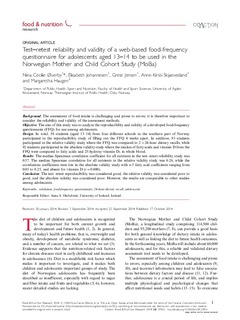| dc.contributor.author | Øverby, Nina Cecilie | |
| dc.contributor.author | Johannesen, Elisabeth | |
| dc.contributor.author | Jensen, Grete | |
| dc.contributor.author | Skjævesland, Anne-Kirsti | |
| dc.contributor.author | Haugen, Margaretha | |
| dc.date.accessioned | 2014-10-27T12:52:06Z | |
| dc.date.available | 2014-10-27T12:52:06Z | |
| dc.date.issued | 2014 | |
| dc.identifier.citation | Øverby, N. C., Johannesen, E., Jensen, G., Skjævesland, A.-K. & Haugen, M. (2014). Test-retest reliability and validity of a web-based food-frequency questionnaire for adolescents aged 13-14 to be used in the Norwegian Mother and Child Cohort Study (MoBa). Food & Nutrition Research, 58: 23956. | nb_NO |
| dc.identifier.issn | 1654-661X | |
| dc.identifier.uri | http://hdl.handle.net/11250/224614 | |
| dc.description.abstract | Background: The assessment of food intake is challenging and prone to errors; it is therefore important to consider the reliability and validity of the assessment methods.
Objective: The aim of this study was to analyze the reproducibility and validity of a developed food-frequency questionnaire (FFQ) for use among adolescents.
Design: In total, 58 students (aged 13 14) from four different schools in the southern part of Norway participated in the reproducibility study of filling out the FFQ 4 weeks apart. In addition, 93 students participated in the relative validity study where the FFQ was compared to 2 24-hour dietary recalls, while 92 students participated in the absolute validity study where the intakes of fatty acids and vitamin D from the FFQ were compared to fatty acids and 25-hydroxy-vitamin D3 in whole blood.
Results: The median Spearman correlation coefficient for all nutrients in the test retest reliability study was 0.57. The median Spearman correlation for all nutrients in the relative validity study was 0.26, while the correlations coefficients were low in the absolute validity study with n-3 fatty acid coefficients ranging from 0.05 to 0.25, and absent for vitamin D (r 0.000).
Conclusion: The test retest reproducibility was considered good, the relative validity was considered poor to good, and the absolute validity was considered poor. However, the results are comparable to other studies among adolescents. | nb_NO |
| dc.language.iso | eng | nb_NO |
| dc.publisher | Swedish Nutrition Foundation | nb_NO |
| dc.rights | Navngivelse-Ikkekommersiell 4.0 Internasjonal | * |
| dc.rights.uri | http://creativecommons.org/licenses/by-nc/4.0/deed.no | * |
| dc.title | Test-retest reliability and validity of a web-based food-frequency questionnaire for adolescents aged 13-14 to be used in the Norwegian Mother and Child Cohort Study (MoBa) | nb_NO |
| dc.type | Journal article | nb_NO |
| dc.type | Peer reviewed | nb_NO |
| dc.rights.holder | © 2014 The Author(s) | |
| dc.subject.nsi | VDP::Medical disciplines: 700::Health sciences: 800::Nutrition: 811 | nb_NO |
| dc.source.pagenumber | 11 | nb_NO |
| dc.source.volume | 58 | nb_NO |
| dc.source.journal | Food & Nutrition Research | nb_NO |
| dc.identifier.doi | https://doi.org/10.3402/fnr.v58.23956 | |
| dc.source.articlenumber | 23956 | |

